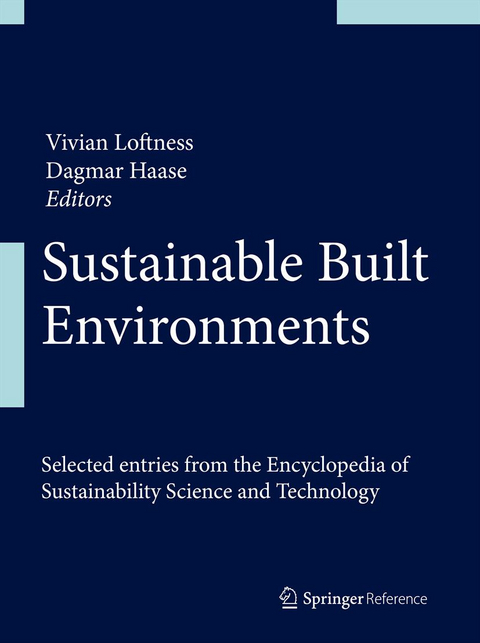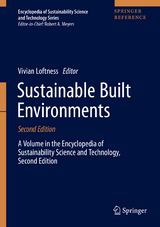
Sustainable Built Environments
Springer-Verlag New York Inc.
978-1-4614-5827-2 (ISBN)
- Titel erscheint in neuer Auflage
- Artikel merken
International experts in the field address the fundamental questions of sustainable design and landscape management: How should the sustainability of landscapes and buildings be evaluated? Which targets have to be set and which thresholds should not be exceeded? What forms of planning and governance structures exist and to what extent do they further the goals of sustainability? Gathering 30 peer-reviewed entries from the Encyclopedia of Sustainability Science and Technology, Sustainable Built Environments provides comprehensive, multidisciplinary coverage of these issues and other aspects of sustainable building and landscape design.
Vivian Loftness, FAIA, is an internationally renowned researcher, author, andeducator focused on environmental design and sustainability, climate and regionalism in architecture, and the integration of advanced building systems for health and productivity. At Carnegie Mellon University, Professor Loftness holds the Paul Mellon Distinguished Chair in Architecture, is one of 40 University Professors, and served a decade as Head of the School of Architecture. With over 30 years of industry and government research funding, she is a key member of Carnegie Mellon’s leadership in sustainability research and education and contributor to the ongoing development of the Intelligent Workplace – a living laboratory of commercial building innovations for performance. Her collaborative research is captured in over 100 journal articles, book chapters, and books, as well in the 2013 and 2020 Springer Reference Encyclopedia of Sustainable Built Environments, for which she serves as Editor. Professor Loftness has served on over 25 Boards of Directors, including EPA’s NACEPT, DOE’s FEMAC, and the National USGBC, AIA, and ILFI Boards. She has served on 12 National Academy of Science panels as well as the Academy’s Board on Infrastructure and the Constructed Environment and given four Congressional testimonies on sustainable design. Her work ha influenced national policy and building projects, including the Adaptable Workplace Lab at the U.S. General Services Administration and the Laboratory for Cognition at Electricity de France. Professor Loftness has been recognized as a LEED Fellow; a Senior Fellow of the Design Futures Council, the New Buildings Institute, and the Scott Energy Institute; and one of 13 Stars of Building Science by the Building Research Establishment in the UK. She received Awards of Distinction from AIA Pennsylvania and NESEA, holds a National Educator Honor Award from the American Institute of Architecture Students, and a “Sacred Tree” Award from the US Green Building Council. Professor Loftness is a Bachelor of Science and Master of Architecture from MIT.
Part I: Sustainable Built Environment.- Bioclimatic Design.- Biofuels and Sustainable Buildings.- Daylight, Indoor Illumination, and Human Behavior.- Daylighting Controls, Performance and Global Impacts.- Facades and Enclosures, Building for Sustainability.- Geothermal Conditioning: Critical Sources for Sustainability.- Indoor Environmental Quality and Health Improvement, Evidence-Based Design for.- Natural Ventilation in Built Environment.- Passive House (Passivhaus).- Passive Solar Heating in Built Environment.- Rating Systems for Sustainability.- Regenerative Development and Design.- Resource Repletion, Role of Buildings.- Sustainability Performance Simulation Tools for Building Design.- Sustainable and Healthy Built Environment.- Sustainable Built Environment, Introduction.- Sustainable Design and Construction, Integrated Delivery Processes and Building Information Modeling.- Sustainable Heating Ventilation and Air Conditioning.- Part II: Sustainable Landscape Design and Green Roof Science and Technology.- Biodiversity in Cities, Reconnecting Humans with Nature.- Green Infrastructure and Climate Change.- Green Roof Infrastructures in Urban Areas.- Green Roof Planning in Urban Areas.- Green Roofs, Ecological Functions.- Landscape Planning for Minimizing Land Consumption.- Landscape Planning for Sustainable Water Usage.- Landscape Planning/Design of Shrinking Landscapes.- Sustainable Landscape Design, Urban Forestry, and Green Roof Science and Technology, Introduction.- Sustainable Landscapes.- Urban Forest Function, Design and Management.- Urban Redevelopment and Quality of Open Spaces.
| Reihe/Serie | Sustainable Built Environments | 1.10 |
|---|---|
| Zusatzinfo | 334 Illustrations, color; 93 Illustrations, black and white; XIV, 746 p. 427 illus., 334 illus. in color. |
| Verlagsort | New York, NY |
| Sprache | englisch |
| Maße | 193 x 260 mm |
| Themenwelt | Naturwissenschaften ► Biologie ► Botanik |
| Naturwissenschaften ► Biologie ► Ökologie / Naturschutz | |
| Technik ► Architektur | |
| Technik ► Bauwesen | |
| Technik ► Elektrotechnik / Energietechnik | |
| ISBN-10 | 1-4614-5827-7 / 1461458277 |
| ISBN-13 | 978-1-4614-5827-2 / 9781461458272 |
| Zustand | Neuware |
| Informationen gemäß Produktsicherheitsverordnung (GPSR) | |
| Haben Sie eine Frage zum Produkt? |
aus dem Bereich



